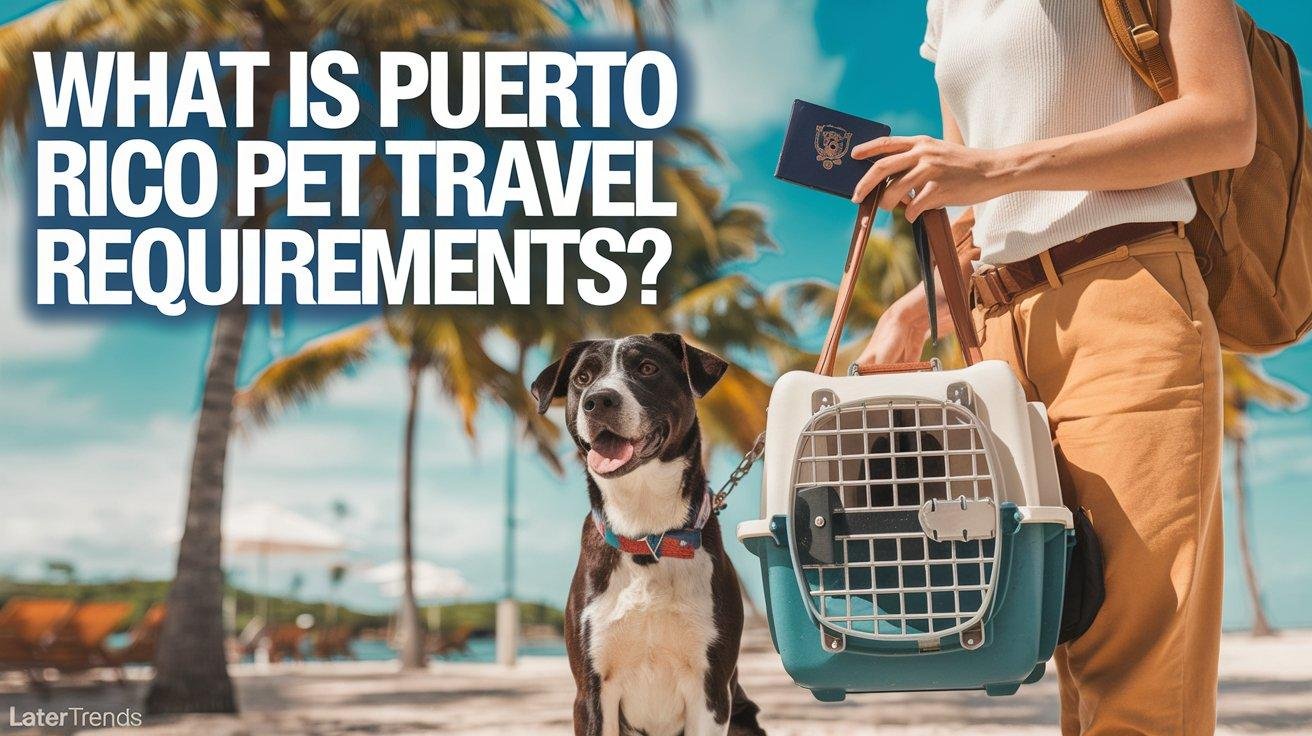To travel to Puerto Rico with a pet, you need a valid Health Certificate issued within 30 days, confirming your pet is disease-free. A Rabies Vaccination Certificate is required for pets over 3 months old, and tick and tapeworm treatments must be documented within 14 days before arrival. While microchipping isn’t mandatory, it’s strongly recommended. Pets must travel in airline-approved carriers, and additional airline-specific rules may apply.
Traveling to this exotic island with your pet can be thrilling, but it needs a lot of planning. Are you planning a tropical vacation and worried about Puerto Rico pet travel requirements?
This article covers the essential documents you need, airline policies, and helpful tips for pet transport to ensure a smooth trip.
You’ll learn everything from obtaining the right health certificates to choosing the best airline for traveling with your pet dog.
Let’s make your travel adventure with your pet memorable. Enjoy pet-friendly San Juan, beaches, and parks in Puerto Rico for a fun and relaxing experience.
What is a Pet Passport?
A pet passport is an official document that allows domestic animals—primarily dogs, cats, and ferrets—to travel across international borders without undergoing lengthy quarantine procedures. It contains essential health and identification records, confirming that your pet meets the import and export requirements of the destination country.
Originally introduced by the European Union, pet passports are now recognized in various formats around the world. Although the exact requirements differ from one country to another, a typical pet passport includes:
- Microchip identification number
- Rabies vaccination certificate
- General health certificate issued by a licensed veterinarian
- Records of deworming and tick/flea treatments (if required)
- Information about the pet’s species, breed, age, and physical description
- Owner’s contact information
While many countries, such as those in the European Union, issue standardized pet passports, others—including the United States and its territories—require equivalent veterinary documentation like USDA health certificates.
If you’re planning to travel with your pet to Puerto Rico or abroad, having a pet passport or an equivalent certified veterinary document is essential to ensure smooth entry and compliance with local regulations.
What is Puerto Rico Pet Travel Requirements?
Although Puerto Rico is a U.S. territory, it maintains its own set of pet import regulations under the Puerto Rico Department of Agriculture, with guidance from the USDA Animal and Plant Health Inspection Service (APHIS). These regulations apply to animals entering Puerto Rico from the mainland United States or foreign countries.
1. Health Certificate (Certificate of Veterinary Inspection)
Every dog or cat entering Puerto Rico must have a valid Health Certificate, also known as a Certificate of Veterinary Inspection (CVI), issued by a licensed veterinarian. The certificate must:
- Be issued within 30 days before arrival
- State that the pet is free from infectious or contagious diseases
- Include details of vaccinations, treatments, and physical condition
If the pet is arriving from outside the U.S., the certificate must be endorsed by the USDA (APHIS).
2. Rabies Vaccination Certificate
Rabies vaccination is mandatory for all dogs and cats over 3 months old. The certificate must:
- Be issued at least 30 days before entry
- Be valid on the date of travel
- Include the vaccine manufacturer, serial number, and expiration date
Puppies and kittens under 3 months are typically not allowed unless they meet special exemptions.
3. Tick and Tapeworm Treatment
Puerto Rico requires documented proof of external and internal parasite treatment, specifically for ticks and tapeworms. This must be administered within 14 days before arrival and documented by the veterinarian on the health certificate.
4. Microchipping
While not currently mandatory, microchipping is strongly recommended. A microchip offers secure and verifiable identification, particularly helpful in case your pet gets lost during travel.
5. Carrier and Transportation Guidelines
- Pets must be transported in USDA-approved travel crates or kennels
- Crates must be clean, well-ventilated, and large enough for the animal to stand and turn around
- The crate must display the pet’s information and the owner’s contact details
- Airlines may have additional restrictions for transporting animals in-cabin or in the cargo hold
Check with your airline before departure to understand any additional requirements such as advanced booking, weather embargoes, or breed restrictions.
Which Animals are Eligible for These Regulations?
Not all animals fall under standard pet passport regulations. The term “pet” in this context typically refers to animals that are commonly domesticated and kept for companionship. These regulations are primarily focused on preventing the spread of diseases—especially rabies—through animal movement.
Animals Commonly Eligible:
- Dogs
- Cats
- Ferrets (particularly in EU countries)
- Some birds, especially parrots, with additional avian-specific rules
- Rabbits, under certain conditions
Animals With Additional or Stricter Rules:
- Rodents, such as guinea pigs and hamsters, often have country-specific rules
- Reptiles and amphibians, which may require special permits or quarantine
- Fish and invertebrates, subject to agricultural import rules and are often excluded from standard passport systems
- Exotic pets, such as monkeys or wild birds, may be restricted or banned entirely
- Livestock, including pigs, goats, and cattle, are not covered by pet passport rules and require agricultural permits
If you are unsure whether your animal qualifies, it is essential to consult with your veterinarian and check the regulations of the country you are visiting. Transporting unauthorized species without proper documentation can result in quarantine, fines, or denial of entry.
How to Select the Right Airline for Pets?
Selecting an airline with pet-friendly policies is essential for ensuring safe animal transport. Here’s what you need to know about popular airlines:
| Airline | Pet in Cabin Fee | Pet in Cargo Fee |
|---|---|---|
| Alaska Airlines | $100 each way | $150 each way |
| American Airlines | $125 each way | Not allowed |
| Delta Air Lines | $95 each way | Not allowed |
| Frontier Airlines | $99 each way | Not allowed |
| Hawaiian Airlines | $125 (Hawaii-North America), $60 (within Hawaii) | Not allowed |
| JetBlue Airways | $125 each way | Not allowed |
| Southwest Airlines | $125 each way | Not allowed |
| Spirit Airlines | $125 each way | Not allowed |
| United Airlines | $125 each way + $125 for long layovers | Not allowed |
JetBlue offers the JetPaws program, which includes travel tips for pet parents. Ensure you confirm all air travel regulations before booking.
Traveling in the Cabin
- Carrier Size: Your pet should be in a carrier that fits in the cabin as a carry-on. Usually, this means the carrier must fit under the seat in front of you.
- Pet Restrictions: Airlines usually allow only small cats and dogs in the cabin, and each passenger can bring just one pet.

Traveling as Cargo
Larger animals must usually travel as cargo baggage in an area specifically designated for transporting animals. This area has pressure, heat, and ventilation just like the cabin. It is safe.
- Temperature Controlled: The lower compartment carrying the animals is temperature and pressure-controlled as much as the cabin is.
- Safety: Animals are secured to avoid a bumpy ride.
- Reservations: It’s important to make reservations for pet travel early. Space is limited, especially during peak travel times when flights often fill up quickly.

How to Prepare Your Pet For The Journey?
Introducing Your Pet to the Carrier
Tips on how to introduce your pet to the carrier long before the journey begins:
- Start Early: Your pet should be allowed inside the carrier many weeks before the intended trip.
- Positive Reinforcement: Reward and praise your pet with treats to develop a liking towards the carrier.
- Short Trips: You should take many short car trips with your pet inside the carrier.
Stress Reduction Tips
- Familiar Items: Bring a favorite toy or a blanket to help comfort your pet on the journey.
- Calm Environment: To keep your pet calm and quiet inside the carrier, especially at the airport, limit distractions. There will be many new sights and sounds around, so stay close and offer comfort.

Read More: living in puerto rico pros and cons: Guide to Island Life
Additional Considerations for International Travel
If you plan to take your pet from Puerto Rico to an international destination, you will likely need:
- A USDA-endorsed international health certificate
- Rabies titer test (for destinations like the EU, Japan, Australia)
- Import permits from the destination country
- Quarantine compliance, depending on the country’s disease status
Start preparing these documents at least 2–3 months in advance of your travel date to avoid last-minute delays.
FAQs
Are there flights to Puerto Rico that allow dogs?
Yes, many airlines allow dogs to travel to Puerto Rico, either in the cabin or as checked baggage. Make sure to check for breed restrictions like those for American Staffordshire Terriers or Pit Bulls.
How long can my dog sit on my lap during a flight?
Alaska Airlines and JetBlue are known for being dog-friendly. They have reasonable fees and provide excellent animal care.
What is the most dog-friendly airline?
When selecting an airline for traveling with your dog, it’s essential to consider factors such as pet policies, fees, and accommodations. Here are some of the most dog-friendly airlines:
| Airline | In-Cabin Fee | Cargo Option | Special Features |
|---|---|---|---|
| Alaska Airlines | $100 | Yes | Pet-friendly policies accommodate various pets |
| American Airlines | $125 | Yes | Extensive network, flexible options |
| Delta Air Lines | $95 | Yes | Pet safety and comfort program |
| Frontier Airlines | $99 | No | Affordable and straightforward pet policies |
| JetBlue | $125 | No | JetPaws program with travel tips and perks |
Conclusion
Meeting the Puerto Rico pet travel requirements is essential for a smooth and exciting holiday with your furry friend. Proper planning and compliance with pet import regulations will ensure your journey is stress-free.
Whether traveling to San Juan or exploring the island’s natural beauty, Puerto Rico offers a fantastic adventure for pet owners. From pet-friendly San Juan to relaxing beaches, your travel memories will be unforgettable.
For additional assistance, consult resources like Pet Travel, The Caribbean Pet, and PetRelocation. Department of Agriculture for updated pet travel requirements.








